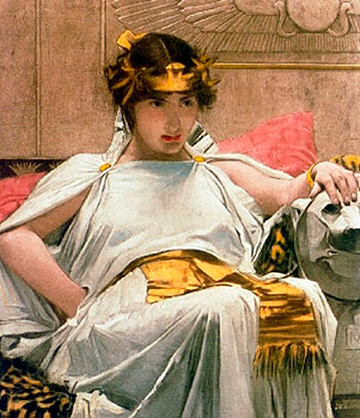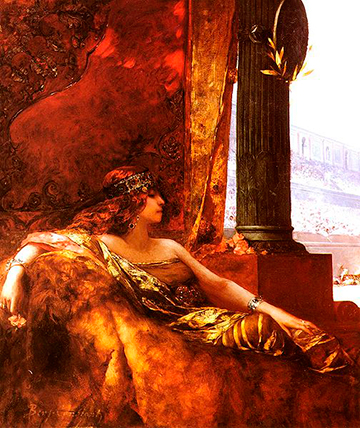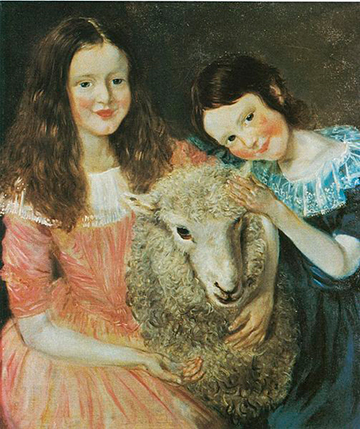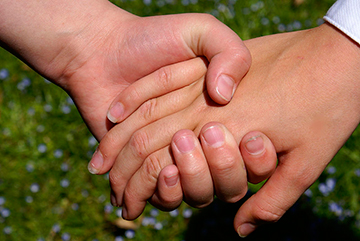How exotic …
I just learned that I am a distant relative of the great Cleopatra herself.

Cleopatra by John William Waterhouse, 1888, via Wikimedia Commons
Honest!
Do you want to know something else?
You are, too.
How do I know this?
How can this be?
“Chances are, if you have a famous ancestor far enough back that finding out about them is a surprise, you share them with a small city of other people,” reveals Veronique Greenwood of Nautilis, an online magazine featuring the most romantic of biological facts.

The Empress Theodora at the Colisseum by Jean-Joseph Benjamin-Constant via Wikimedia Commons
This epiphany stems from a 2004 study of human genetics which showed that anyone who was living 2,000 to 3,000 years ago is either the ancestor of everyone who is living today,
or no one at all.
Rather mind-boggling, isn’t it?
“It doesn’t get any less weird when you look at it from the other angle,” writes Greenwood. “While you more than likely have four distinct grandparents and eight distinct great-grandparents, past a certain number of generations back, your number of ancestors stops growing exponentially, because they start being the same people.”
Take a minute to think about that.
She goes on, in fact-and-figure scientific terms, to explain that most of the people from whom we’re descended are no more genetically related to us than most strangers we pass on the street.
Something about that sounds a little discouraging …
So many of us love delving into our ancestry, learning where—and who—we came from. Even the farthest tips of our family trees can offer us a better sense of ourselves (and give us historical context to which we can attribute our unique characters and all of their quirks).
But, Greenwood insists that there is a superbly heartening way to interpret this data. “We’re more closely tied to our species as a whole than we might have realized,” she tells us. “We’re all part of this enormous human fabric, full of fascinating tendencies and bizarre biochemistry—that’s a tradition to be proud of.”

Portrait of The sisters Cathinca and Anna Elisabeth Glückstad by Matthias Stoltenberg via Wikimedia Commons
Here, here!
Instead of focusing on our degrees of separation, I choose to see our innate connections. We share common ancestry, after all, and I believe that brings us closer together.

Photo by Elizabeth Ann Colette via Wikimedia Commons
Do you think Cleopatra would agree?





















































This is an interesting thought here. Related to Cleopatra? That does not excite me nearly as much as say Queen Elizabeth I or Elinor of Aquitaine. But, I am in total agreement that what is important here is that we have a richer existence when we don’t see ourselves as separate from others. When we see ourselves as “sisters” then the barriers drop and we can learn from each other and see the good in our diversity.
Having no siblings and no children (My deep thanks go to my hubby, that because of him, I at least have nieces and nephews!) I am truly happy with any news that I am related to you MaryJane! Well, ok, I extrapolated the thought of you AND I being related to Cleo into you and I being related. I somehow knew it all along. Couldn’t be happier…
Farmgirl SISTER no.89
My grandma passed away 6 months ago and my family and I have been going through everything before her house is sold. I’ve discovered so many interesting things including the lineage of my great grandpa, Sherman G. Peticolas which traces all the way back to Egbert, King of Wessex 800-856 a.d. Family history is so interesting and I wouldn’t doubt that in the grand picture that we are all related!
Mitochondrial DNA has proven that we descend from one woman … even further back than Cleopatra. Yes, the first, the one & only Eve. Sorry, no ape DNA present.
In the July 2013 issue of Nat Geo, there is a fascinating feature about the many shared genes we have in common with different species. I didn’t know we share genes with many things, from rice to rhinos. 65% with chickens, 84% with dogs, 88% with mice, 90% with chimpanzees, and this one spoke to me–85% with cows! Exploring the genomes of other species sheds light on genes involved in human biology and disease.